Hierarchical Classification of Subject-Cooperative Control Strategies for Lower Limb Exoskeletons in Gait Rehabilitation: A Systematic Review
Abstract
1. Introduction
1.1. Lower Limb Exoskeletons
1.2. Control of LLEs
2. Search Methodology for Systematic Review
3. Hierarchical Classification of Control Strategies
3.1. Upper-Level Control
3.1.1. Supervisory Control
3.1.2. Higher-Level Control
3.2. Lower-Level Control
3.2.1. Robust Control
3.2.2. Intelligent Control
4. Discussion
5. Conclusions
Author Contributions
Funding
Data Availability Statement
Acknowledgments
Conflicts of Interest
References
- Frigon, A. The neural control of interlimb coordination during mammalian locomotion. J. Neurophysiol. 2017, 117, 2224–2241. [Google Scholar] [CrossRef] [PubMed]
- WHO. Disability and Health. 2022. Available online: https://www.who.int/news-room/fact-sheets/detail/disability-and-health (accessed on 3 May 2023).
- Johnson, C.C. The benefits of physical activity for youth with developmental disabilities: A systematic review. Am. J. Health Promot. 2009, 23, 157–167. [Google Scholar] [CrossRef]
- Rupal, B.S.; Rafique, S.; Singla, A.; Singla, E.; Isaksson, M.; Virk, G.S. Lower-limb exoskeletons: Research trends and regulatory guidelines in medical and non-medical applications. Int. J. Adv. Robot. Syst. 2017, 14. [Google Scholar] [CrossRef]
- Jamwal, P.K.; Hussain, S.; Ghayesh, M.H. Robotic orthoses for gait rehabilitation: An overview of mechanical design and control strategies. Proc. Inst. Mech. Eng. Part H J. Eng. Med. 2020, 234, 444–457. [Google Scholar] [CrossRef] [PubMed]
- Kalita, B.; Narayan, J.; Dwivedy, S.K. Development of active lower limb robotic-based orthosis and exoskeleton devices: A systematic review. Int. J. Soc. Robot. 2021, 13, 775–793. [Google Scholar] [CrossRef]
- Barrera Sánchez, A.; Blanco Ortega, A.; Martínez Rayón, E.; Gómez Becerra, F.A.; Abúndez Pliego, A.; Campos Amezcua, R.; Guzmán Valdivia, C.H. State of the Art Review of Active and Passive Knee Orthoses. Machines 2022, 10, 865. [Google Scholar] [CrossRef]
- Wang, T.; Zhang, B.; Liu, C.; Liu, T.; Han, Y.; Wang, S.; Ferreira, J.P.; Dong, W.; Zhang, X. A Review on the Rehabilitation Exoskeletons for the Lower Limbs of the Elderly and the Disabled. Electronics 2022, 11, 388. [Google Scholar] [CrossRef]
- Lee, H.; Ferguson, P.W.; Rosen, J. Lower limb exoskeleton systems—Overview. In Wearable Robotics; Academic Press: Cambridge, MA, USA, 2020; pp. 207–229. [Google Scholar]
- Aguirre-Ollinger, G. Learning muscle activation patterns via nonlinear oscillators: Application to lower-limb assistance. In Proceedings of the 2013 IEEE/RSJ International Conference on Intelligent Robots and Systems, Tokyo, Japan, 3–7 November 2013; pp. 1182–1189. [Google Scholar]
- Sanz-Merodio, D.; Cestari, M.; Arevalo, J.C.; Carrillo, X.A.; Garcia, E. Generation and control of adaptive gaits in lower-limb exoskeletons for motion assistance. Adv. Robot. 2014, 28, 329–338. [Google Scholar] [CrossRef]
- Wei, W.; Zha, S.; Xia, Y.; Gu, J.; Lin, X. A hip active assisted exoskeleton that assists the semi-squat lifting. Appl. Sci. 2020, 10, 2424. [Google Scholar] [CrossRef]
- Lenzi, T.; Carrozza, M.C.; Agrawal, S.K. Powered hip exoskeletons can reduce the user’s hip and ankle muscle activations during walking. IEEE Trans. Neural Syst. Rehabil. Eng. 2013, 21, 938–948. [Google Scholar] [CrossRef]
- Aycardi, L.F.; Cifuentes, C.A.; Múnera, M.; Bayón, C.; Ramírez, O.; Lerma, S.; Frizera, A.; Rocon, E. Evaluation of biomechanical gait parameters of patients with Cerebral Palsy at three different levels of gait assistance using the CPWalker. J. Neuroeng. Rehabil. 2019, 16, 15. [Google Scholar] [CrossRef]
- Gao, M.; Wang, Z.; Pang, Z.; Sun, J.; Li, J.; Li, S.; Zhang, H. Electrically Driven Lower Limb Exoskeleton Rehabilitation Robot Based on Anthropomorphic Design. Machines 2022, 10, 266. [Google Scholar] [CrossRef]
- Chen, S.; Han, T.; Dong, F.; Lu, L.; Liu, H.; Tian, X.; Han, J. Precision interaction force control of an underactuated hydraulic stance leg exoskeleton considering the constraint from the wearer. Machines 2021, 9, 96. [Google Scholar] [CrossRef]
- Zhou, N.; Liu, Y.; Song, Q.; Wu, D. A Compatible Design of a Passive Exoskeleton to Reduce the Body–Exoskeleton Interaction Force. Machines 2022, 10, 371. [Google Scholar] [CrossRef]
- Al-Dahiree, O.S.; Ghazilla, R.A.R.; Tokhi, M.O.; Yap, H.J.; Albaadani, E.A. Design of a Compact Energy Storage with Rotary Series Elastic Actuator for Lumbar Support Exoskeleton. Machines 2022, 10, 584. [Google Scholar] [CrossRef]
- Kalita, B.; Leonessa, A.; Dwivedy, S.K. A review on the development of pneumatic artificial muscle actuators: Force model and application. Actuators 2022, 11, 288. [Google Scholar] [CrossRef]
- Tsuneyasu, K.; Ohno, A.; Fukuda, Y.; Ogawa, K.; Tsuji, T.; Kurita, Y. A soft exoskeleton suit to reduce muscle fatigue with pneumatic artificial muscles. In Proceedings of the 9th Augmented Human International Conference, Seoul, Republic of Korea, 7–9 February 2018; pp. 1–4. [Google Scholar]
- Marchal-Crespo, L.; Reinkensmeyer, D.J. Review of control strategies for robotic movement training after neurologic injury. J. Neuroeng. Rehabil. 2009, 6, 20. [Google Scholar] [CrossRef]
- Nizamis, K.; Athanasiou, A.; Almpani, S.; Dimitrousis, C.; Astaras, A. Converging robotic technologies in targeted neural rehabilitation: A review of emerging solutions and challenges. Sensors 2021, 21, 2084. [Google Scholar] [CrossRef]
- Zhang, L.; Guo, S.; Sun, Q. An assist-as-needed controller for passive, assistant, active, and resistive robot-aided rehabilitation training of the upper extremity. Appl. Sci. 2020, 11, 340. [Google Scholar] [CrossRef]
- Dong, M.; Yuan, J.; Li, J. A Lower Limb Rehabilitation Robot with Rigid-Flexible Characteristics and Multi-Mode Exercises. Machines 2022, 10, 918. [Google Scholar] [CrossRef]
- Ayas, M.S.; Altas, I. Fuzzy logic based adaptive admittance control of a redundantly actuated ankle rehabilitation robot. Control Eng. Pract. 2017, 59, 44–54. [Google Scholar] [CrossRef]
- Chen, B.; Zhong, C.H.; Zhao, X.; Ma, H.; Guan, X.; Li, X.; Liang, F.-Y.; Cheng, J.C.Y.; Qin, L.; Law, S.-W.; et al. A wearable exoskeleton suit for motion assistance to paralysed patients. J. Orthop. Transl. 2017, 11, 7–18. [Google Scholar] [CrossRef] [PubMed]
- d’Elia, N.; Vanetti, F.; Cempini, M.; Pasquini, G.; Parri, A.; Rabuffetti, M.; Ferrarin, M.; Molino Lova, R.; Vitiello, N. Physical human-robot interaction of an active pelvis orthosis: Toward ergonomic assessment of wearable robots. J. Neuroeng. Rehabil. 2017, 14, 29. [Google Scholar] [CrossRef]
- Patane, F.; Rossi, S.; Del Sette, F.; Taborri, J.; Cappa, P. WAKE-Up exoskeleton to assist children with cerebral palsy: Design and preliminary evaluation in level walking. IEEE Trans. Neural Syst. Rehabil. Eng. 2017, 25, 906–916. [Google Scholar] [CrossRef] [PubMed]
- Yang, P.; Zhang, G.; Wang, J.; Wang, X.; Zhang, L.; Chen, L. Command filter backstepping sliding model control for lower-limb exoskeleton. Math. Probl. Eng. 2017, 2017, 1064535. [Google Scholar] [CrossRef]
- Lerner, Z.F.; Gasparri, G.M.; Bair, M.O.; Lawson, J.L.; Luque, J.; Harvey, T.A.; Lerner, A.T. An untethered ankle exoskeleton improves walking economy in a pilot study of individuals with cerebral palsy. IEEE Trans. Neural Syst. Rehabil. Eng. 2018, 26, 1985–1993. [Google Scholar] [CrossRef]
- Khamar, M.; Edrisi, M. Designing a backstepping sliding mode controller for an assistant human knee exoskeleton based on nonlinear disturbance observer. Mechatronics 2018, 54, 121–132. [Google Scholar] [CrossRef]
- Luo, R.; Sun, S.; Zhao, X.; Zhang, Y.; Tang, Y. Adaptive CPG-based impedance control for assistive lower limb exoskeleton. In Proceedings of the 2018 IEEE International Conference on Robotics and Biomimetics (ROBIO), Kuala Lumpur, Malaysia, 12–15 December 2018; pp. 685–690. [Google Scholar]
- Han, S.; Wang, H.; Tian, Y. Model-free based adaptive nonsingular fast terminal sliding mode control with time-delay estimation for a 12 DOF multi-functional lower limb exoskeleton. Adv. Eng. Softw. 2018, 119, 38–47. [Google Scholar] [CrossRef]
- Zhang, X.; Wang, H.; Tian, Y.; Peyrodie, L.; Wang, X. Model-free based neural network control with time-delay estimation for lower extremity exoskeleton. Neurocomputing 2018, 272, 178–188. [Google Scholar] [CrossRef]
- Taherifar, A.; Vossoughi, G.; Ghafari, A.S. Variable admittance control of the exoskeleton for gait rehabilitation based on a novel strength metric. Robotica 2018, 36, 427–447. [Google Scholar] [CrossRef]
- Eguren, D.; Cestari, M.; Luu, T.P.; Kilicarslan, A.; Steele, A.; Contreras-Vidal, J.L. Design of a customizable, modular pediatric exoskeleton for rehabilitation and mobility. In Proceedings of the 2019 IEEE International Conference on Systems, Man and Cybernetics (SMC), Bari, Italy, 6–9 October 2019; pp. 2411–2416. [Google Scholar]
- Lyu, M.; Chen, W.H.; Ding, X.; Wang, J.; Pei, Z.; Zhang, B. Development of an EMG-controlled knee exoskeleton to assist home rehabilitation in a game context. Front. Neurorobot. 2019, 13, 67. [Google Scholar] [CrossRef] [PubMed]
- Chen, C.F.; Du, Z.J.; He, L.; Wang, J.Q.; Wu, D.M.; Dong, W. Active disturbance rejection with fast terminal sliding mode control for a lower limb exoskeleton in swing phase. IEEE Access 2019, 7, 72343–72357. [Google Scholar] [CrossRef]
- Chen, L.; Wang, C.; Song, X.; Wang, J.; Zhang, T.; Li, X. Dynamic trajectory adjustment of lower limb exoskeleton in swing phase based on impedance control strategy. Proc. Inst. Mech. Eng. Part I J. Syst. Control Eng. 2020, 234, 1120–1132. [Google Scholar] [CrossRef]
- Almaghout, K.; Tarvirdizadeh, B.; Alipour, K.; Hadi, A. Design and control of a lower limb rehabilitation robot considering undesirable torques of the patient’s limb. Proc. Inst. Mech. Eng. Part H J. Eng. Med. 2020, 234, 1457–1471. [Google Scholar] [CrossRef] [PubMed]
- Chen, C.; Zhang, S.; Zhu, X.; Shen, J.; Xu, Z. Disturbance observer-based patient-cooperative control of a lower extremity rehabilitation exoskeleton. Int. J. Precis. Eng. Manuf. 2020, 21, 957–968. [Google Scholar] [CrossRef]
- Gui, K.; Tan, U.X.; Liu, H.; Zhang, D. Electromyography-driven progressive assist-as-needed control for lower limb exoskeleton. IEEE Trans. Med. Robot. Bionics 2020, 2, 50–58. [Google Scholar] [CrossRef]
- Sun, W.; Lin, J.W.; Su, S.F.; Wang, N.; Er, M.J. Reduced adaptive fuzzy decoupling control for lower limb exoskeleton. IEEE Trans. Cybern. 2020, 51, 1099–1109. [Google Scholar] [CrossRef]
- Yin, G.; Zhang, X.; Chen, D.; Li, H.; Chen, J.; Chen, C.; Lemos, S. Processing surface EMG signals for exoskeleton motion control. Front. Neurorobot. 2020, 14, 40. [Google Scholar] [CrossRef]
- Tu, Y.; Zhu, A.; Song, J.; Shen, H.; Shen, Z.; Zhang, X.; Cao, G. An adaptive sliding mode variable admittance control method for lower limb rehabilitation exoskeleton robot. Appl. Sci. 2020, 10, 2536. [Google Scholar] [CrossRef]
- Chen, J.; Hochstein, J.; Kim, C.; Tucker, L.; Hammel, L.E.; Damiano, D.L.; Bulea, T.C. A pediatric knee exoskeleton with real-time adaptive control for overground walking in ambulatory individuals with cerebral palsy. Front. Robot. AI 2021, 8, 702137. [Google Scholar] [CrossRef]
- Wang, S.A.; Zhang, B.; Yu, Z.; Yan, Y. Differential soft sensor-based measurement of interactive force and assistive torque for a robotic hip exoskeleton. Sensors 2021, 21, 6545. [Google Scholar] [CrossRef]
- Andrade, R.M.; Sapienza, S.; Fabara, E.E.; Bonato, P. Trajectory tracking impedance controller in 6-DoF lower-limb exoskeleton for over-ground walking training: Preliminary results. In Proceedings of the 2021 International Symposium on Medical Robotics (ISMR), Atlanta, GA, USA, 17–19 November 2021; pp. 1–6. [Google Scholar]
- Narayan, J.; Abbas, M.; Patel, B.; Dwivedy, S.K. A Singularity-Free Terminal Sliding Mode Control of an Uncertain Paediatric Exoskeleton System. In Proceedings of the 2022 5th International Conference on Advanced Systems and Emergent Technologies (IC_ASET), Hammamet, Tunisia, 22–25 March 2022; pp. 198–203. [Google Scholar]
- Lian, P.; He, Y.; Ma, Y.; Liu, J.; Wu, X. Adaptive admittance control of human-exoskeleton system using rnn optimization. In Proceedings of the 2021 IEEE International Conference on Real-Time Computing and Robotics (RCAR), Xining, China, 15–19 July 2021; pp. 584–589. [Google Scholar]
- Mokhtari, M.; Taghizadeh, M.J.; Mazare, M. Impedance control based on optimal adaptive high order super twisting sliding mode for a 7-dof lower limb exoskeleton. Meccanica 2021, 56, 535–548. [Google Scholar] [CrossRef]
- Yin, Z.; Zheng, J.; Huang, L.; Gao, Y.; Peng, H.; Yin, L. SA-SVM-based locomotion pattern recognition for exoskeleton robot. Appl. Sci. 2021, 11, 5573. [Google Scholar] [CrossRef]
- Susanto, S.; Simorangkir, I.T.; Analia, R.; Pamungkas, D.S.; Soebhakti, H.; Sani, A.; Caesarendra, W. Real-time identification of knee joint walking gait as preliminary signal for developing lower limb exoskeleton. Electronics 2021, 10, 2117. [Google Scholar] [CrossRef]
- Hu, N.; Wang, A.; Wu, Y. Robust adaptive PD-like control of lower limb rehabilitation robot based on human movement data. PeerJ Comput. Sci. 2021, 7, e394. [Google Scholar] [CrossRef]
- Foroutannia, A.; Akbarzadeh-T, M.-R.; Akbarzadeh, A. A deep learning strategy for EMG-based joint position prediction in hip exoskeleton assistive robots. Biomed. Signal Process. Control 2022, 75, 103557. [Google Scholar] [CrossRef]
- Laubscher, C.A.; Goo, A.; Farris, R.J.; Sawicki, J.T. Hybrid impedance-sliding mode switching control of the indego explorer lower-limb exoskeleton in able-bodied walking. J. Intell. Robot. Syst. 2022, 104, 76. [Google Scholar] [CrossRef]
- Fuentes-Alvarez, R.; Hernandez, J.H.; Matehuala-Moran, I.; Alfaro-Ponce, M.; Lopez-Gutierrez, R.; Salazar, S.; Lozano, R. Assistive robotic exoskeleton using recurrent neural networks for decision taking for the robust trajectory tracking. Expert Syst. Appl. 2022, 193, 116482. [Google Scholar] [CrossRef]
- Hasan, S.; Dhingra, A.K. Biomechanical design and control of an eight DOF human lower extremity rehabilitation exoskeleton robot. Results Control Optim. 2022, 7, 100107. [Google Scholar] [CrossRef]
- Moodi, H.; Zamani Nemat Sara, B.; Bustan, D. Adaptive Robust Variable Impedance Controller for Lower Limb Rehabilitation Robot with Augmented Type-2 Fuzzy System. Iran. J. Sci. Technol. Trans. Electr. Eng. 2022, 46, 1029–1039. [Google Scholar] [CrossRef]
- Narayan, J.; Abbas, M.; Dwivedy, S.K. Robust adaptive backstepping control for a lower-limb exoskeleton system with model uncertainties and external disturbances. Automatika 2023, 64, 145–161. [Google Scholar] [CrossRef]
- Narayan, J.; Patel, B.M.; Abbas, M.; Shivhare, G.; Dwivedy, S.K. Cooperative control of a pediatric exoskeleton system for active-assist gait rehabilitation. In Proceedings of the 2022 IEEE International Conference on Electronics, Computing and Communication Technologies (CONECCT), Bangalore, India, 8–10 July 2022; pp. 1–6. [Google Scholar]
- Su, Q.; Pei, Z.; Tang, Z. Nonlinear Control of a Hydraulic Exoskeleton 1-DOF Joint Based on a Hardware-In-The-Loop Simulation. Machines 2022, 10, 607. [Google Scholar] [CrossRef]
- Wang, J.; Liu, J.; Zhang, G.; Guo, S. Periodic event-triggered sliding mode control for lower limb exoskeleton based on human–robot cooperation. ISA Trans. 2022, 123, 87–97. [Google Scholar] [CrossRef] [PubMed]
- Zhu, S.; Zhou, S.; Chen, Z.; Song, W.; Jin, L. Gait-stride-and-frequency-based human intention recognition approach and experimental verification on lower limb exoskeleton. Trans. Inst. Meas. Control 2022, 44, 1149–1160. [Google Scholar] [CrossRef]
- Roy, G.; Bhoi, A.K.; Das, S.; Bhaumik, S. Cross-correlated spectral entropy-based classification of EEG motor imagery signal for triggering lower limb exoskeleton. Signal Image Video Process. 2022, 16, 1831–1839. [Google Scholar] [CrossRef]
- Qi, Z.; Song, Q.; Liu, Y.; Guo, C. Fsm-hsvm-based locomotion mode recognition for exoskeleton robot. Appl. Sci. 2022, 12, 5483. [Google Scholar] [CrossRef]
- Aljuboury, A.S.; Hameed, A.H.; Ajel, A.R.; Humaidi, A.J.; Alkhayyat, A.; Al Mhdawi, A.K. Robust adaptive control of knee exoskeleton-assistant system based on nonlinear disturbance observer. Actuators 2022, 11, 78. [Google Scholar] [CrossRef]
- He, H.; Xi, R.; Gong, Y. Performance Analysis of a Robust Controller with Neural Network Algorithm for Compliance Tendon–Sheath Actuation Lower Limb Exoskeleton. Machines 2022, 10, 1064. [Google Scholar] [CrossRef]
- Amiri, M.S.; Ramli, R.; Aliman, N. Adaptive Swarm Fuzzy Logic Controller of Multi-Joint Lower Limb Assistive Robot. Machines 2022, 10, 425. [Google Scholar] [CrossRef]
- Chen, Z.; Guo, Q.; Li, T.; Yan, Y.; Jiang, D. Gait prediction and variable admittance control for lower limb exoskeleton with measurement delay and extended-state-observer. IEEE Trans. Neural Netw. Learn. Syst. 2022. [Google Scholar] [CrossRef]
- Zhang, P.; Zhang, J.; Elsabbagh, A. Fuzzy radial-based impedance controller design for lower limb exoskeleton robot. Robotica 2023, 41, 326–345. [Google Scholar] [CrossRef]
- Chen, W.; Lyu, M.; Ding, X.; Wang, J.; Zhang, J. Electromyography-controlled lower extremity exoskeleton to provide wearers flexibility in walking. Biomed. Signal Process. Control 2023, 79, 104096. [Google Scholar] [CrossRef]
- Quiles, V.; Ferrero, L.; Iáñez, E.; Ortiz, M.; Gil-Agudo, Á.; Azorín, J.M. Brain-machine interface based on transfer-learning for detecting the appearance of obstacles during exoskeleton-assisted walking. Front. Neurosci. 2023, 17, 1154480. [Google Scholar] [CrossRef] [PubMed]
- Di Marco, R.; Rubega, M.; Lennon, O.; Vianello, A.; Masiero, S.; Formaggio, E.; Del Felice, A. Exoskeleton Training Modulates Complexity in Movement Patterns and Cortical Activity in Able-Bodied Volunteers. IEEE Trans. Neural Syst. Rehabil. Eng. 2023, 31, 2381–2390. [Google Scholar] [CrossRef]
- Sun, Y.; Hu, J.; Huang, R. Negative-Stiffness Structure Vibration-Isolation Design and Impedance Control for a Lower Limb Exoskeleton Robot. Actuators 2023, 12, 147. [Google Scholar] [CrossRef]
- Foroutannia, A.; Akbarzadeh-T, M.-R.; Akbarzadeh, A.; Tahamipour-Z, S.M. Adaptive fuzzy impedance control of exoskeleton robots with electromyography-based convolutional neural networks for human intended trajectory estimation. Mechatronics 2023, 91, 102952. [Google Scholar] [CrossRef]
- Tucker, M.R.; Olivier, J.; Pagel, A.; Bleuler, H.; Bouri, M.; Lambercy, O.; Millán, J.d.R.; Riener, R.; Vallery, H.; Gassert, R. Control strategies for active lower extremity prosthetics and orthotics: A review. J. Neuroeng. Rehabil. 2015, 12, 1. [Google Scholar] [CrossRef]
- Tijjani, I.; Kumar, S.; Boukheddimi, M. A survey on design and control of lower extremity exoskeletons for bipedal walking. Appl. Sci. 2022, 12, 2395. [Google Scholar] [CrossRef]
- Sawicki, G.S.; Beck, O.N.; Kang, I.; Young, A.J. The exoskeleton expansion: Improving walking and running economy. J. Neuroeng. Rehabil. 2020, 17, 25. [Google Scholar] [CrossRef]
- Kalita, B.; Dwivedy, S. Dynamic analysis of pneumatic artificial muscle (PAM) actuator for rehabilitation with principal parametric resonance condition. Nonlinear Dyn. 2019, 97, 2271–2289. [Google Scholar] [CrossRef]
- Baud, R.; Manzoori, A.R.; Ijspeert, A.; Bouri, M. Review of control strategies for lower-limb exoskeletons to assist gait. J. Neuroeng. Rehabil. 2021, 18, 119. [Google Scholar] [CrossRef]
- Borisov, A.; Kaspirovich, I.; Mukharlyamov, R. On Mathematical Modeling of the Dynamics of Multilink Systems and Exoskeletons. J. Comput. Syst. Sci. Int. 2021, 60, 827–841. [Google Scholar] [CrossRef]
- Tiboni, M.; Borboni, A.; Vérité, F.; Bregoli, C.; Amici, C. Sensors and actuation technologies in exoskeletons: A review. Sensors 2022, 22, 884. [Google Scholar] [CrossRef]
- Shi, D.; Zhang, W.; Zhang, W.; Ding, X. A review on lower limb rehabilitation exoskeleton robots. Chin. J. Mech. Eng. 2019, 32, 74. [Google Scholar] [CrossRef]
- Sarajchi, M.; Al-Hares, M.K.; Sirlantzis, K. Wearable Lower-Limb Exoskeleton for Children with Cerebral Palsy: A Systematic Review of Mechanical Design, Actuation Type, Control Strategy, and Clinical Evaluation. IEEE Trans. Neural Syst. Rehabil. Eng. 2021, 29, 2695–2720. [Google Scholar] [CrossRef] [PubMed]
- Shi, D.; Wang, L.; Zhang, Y.; Zhang, W.; Xiao, H.; Ding, X. Review of human–robot coordination control for rehabilitation based on motor function evaluation. Front. Mech. Eng. 2022, 17, 28. [Google Scholar] [CrossRef]
- Yang, C.; Yu, L.; Xu, L.; Yan, Z.; Hu, D.; Zhang, S.; Yang, W. Current developments of robotic hip exoskeleton toward sensing, decision, and actuation: A review. Wearable Technol. 2022, 3, e15. [Google Scholar] [CrossRef]
- Al-Waeli, K.H.; Ramli, R.; Haris, S.M.; Zulkoffli, Z.B. Development of gait rehabilitation devices: A review of the literature. Mech. Eng. J. 2023, 10, 22–00450. [Google Scholar] [CrossRef]
- Moher, D.; Liberati, A.; Tetzlaff, J.; Altman, D.G.; for the PRISMA Group. Preferred reporting items for systematic reviews and meta-analyses: The PRISMA statement. Ann. Intern. Med. 2009, 151, 264–269. [Google Scholar] [CrossRef]
- Fleischer, C.; Hommel, G. A human–exoskeleton interface utilizing electromyography. IEEE Trans. Robot. 2008, 24, 872–882. [Google Scholar] [CrossRef]
- Al-Quraishi, M.S.; Elamvazuthi, I.; Daud, S.A.; Parasuraman, S.; Borboni, A. EEG-based control for upper and lower limb exoskeletons and prostheses: A systematic review. Sensors 2018, 18, 3342. [Google Scholar] [CrossRef]
- Arciniegas-Mayag, L.; Rodriguez-Guerrero, C.; Rocon, E.; Munera, M.; Cifuentes, C.A. Impedance control strategies for lower-limb exoskeletons. In Interfacing Humans and Robots for Gait Assistance and Rehabilitation; Springer: Cham, Switzerland, 2022; pp. 213–236. [Google Scholar]
- Kong, K.; Jeon, D. Design and control of an exoskeleton for the elderly and patients. IEEE/ASME Trans. Mechatron. 2006, 11, 428–432. [Google Scholar] [CrossRef]
- Mori, Y.; Okada, J.; Takayama, K. Development of a standing style transfer system “able” for disabled lower limbs. IEEE/ASME Trans. Mechatron. 2006, 11, 372–380. [Google Scholar] [CrossRef]
- Estrada, A.; Fridman, L.; Iriarte, R. Combined backstepping and HOSM control design for a class of nonlinear MIMO systems. Int. J. Robust Nonlinear Control 2017, 27, 566–581. [Google Scholar] [CrossRef]
- Zhou, J.; Wen, C. Adaptive Backstepping Control of Uncertain Systems: Nonsmooth Nonlinearities, Interactions or Time-Variations; Springer: Berlin/Heidelberg, Germany, 2008. [Google Scholar]
- Abbas, M.; Al Issa, S.; Dwivedy, S.K. Event-triggered adaptive hybrid position-force control for robot-assisted ultrasonic examination system. J. Intell. Robot. Syst. 2021, 102, 1–19. [Google Scholar] [CrossRef]
- Li, C.Y.; Jing, W.X.; Gao, C.S. Adaptive backstepping-based flight control system using integral filters. Aerosp. Sci. Technol. 2009, 13, 105–113. [Google Scholar] [CrossRef]
- Wang, F.; Zou, Q.; Zong, Q. Robust adaptive backstepping control for an uncertain nonlinear system with input constraint based on Lyapunov redesign. Int. J. Control. Autom. Syst. 2017, 15, 212–225. [Google Scholar] [CrossRef]
- Guo, Q.; Zhang, Y.; Celler, B.G.; Su, S.W. Neural adaptive backstepping control of a robotic manipulator with prescribed performance constraint. IEEE Trans. Neural Netw. Learn. Syst. 2018, 30, 3572–3583. [Google Scholar] [CrossRef]
- Coban, R. Adaptive backstepping sliding mode control with tuning functions for nonlinear uncertain systems. Int. J. Syst. Sci. 2019, 50, 1517–1529. [Google Scholar] [CrossRef]
- Narayan, J.; Dwivedy, S.K. Towards neuro-fuzzy compensated PID control of lower extremity exoskeleton system for passive gait rehabilitation. IETE J. Res. 2023, 69, 778–795. [Google Scholar] [CrossRef]
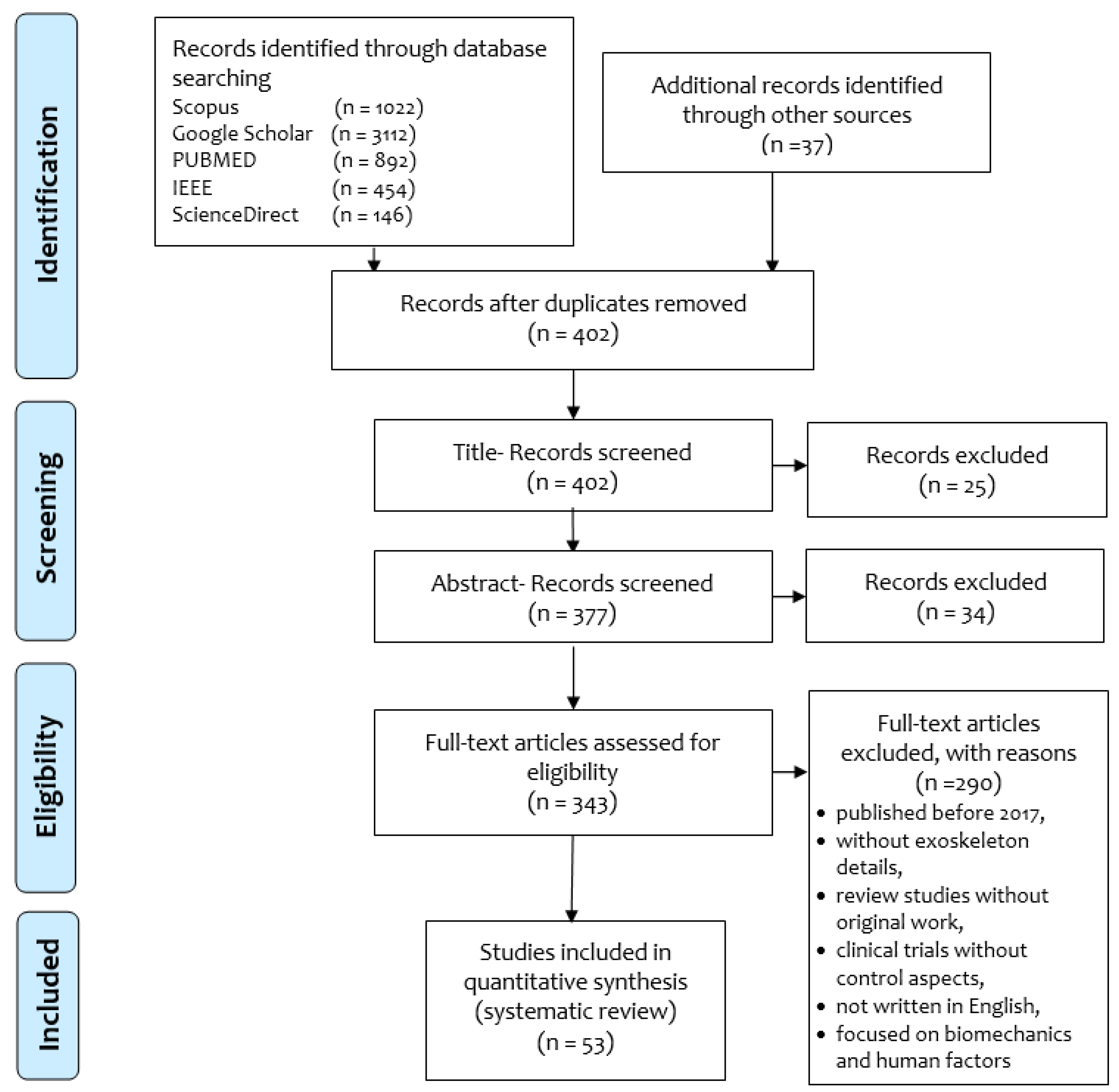
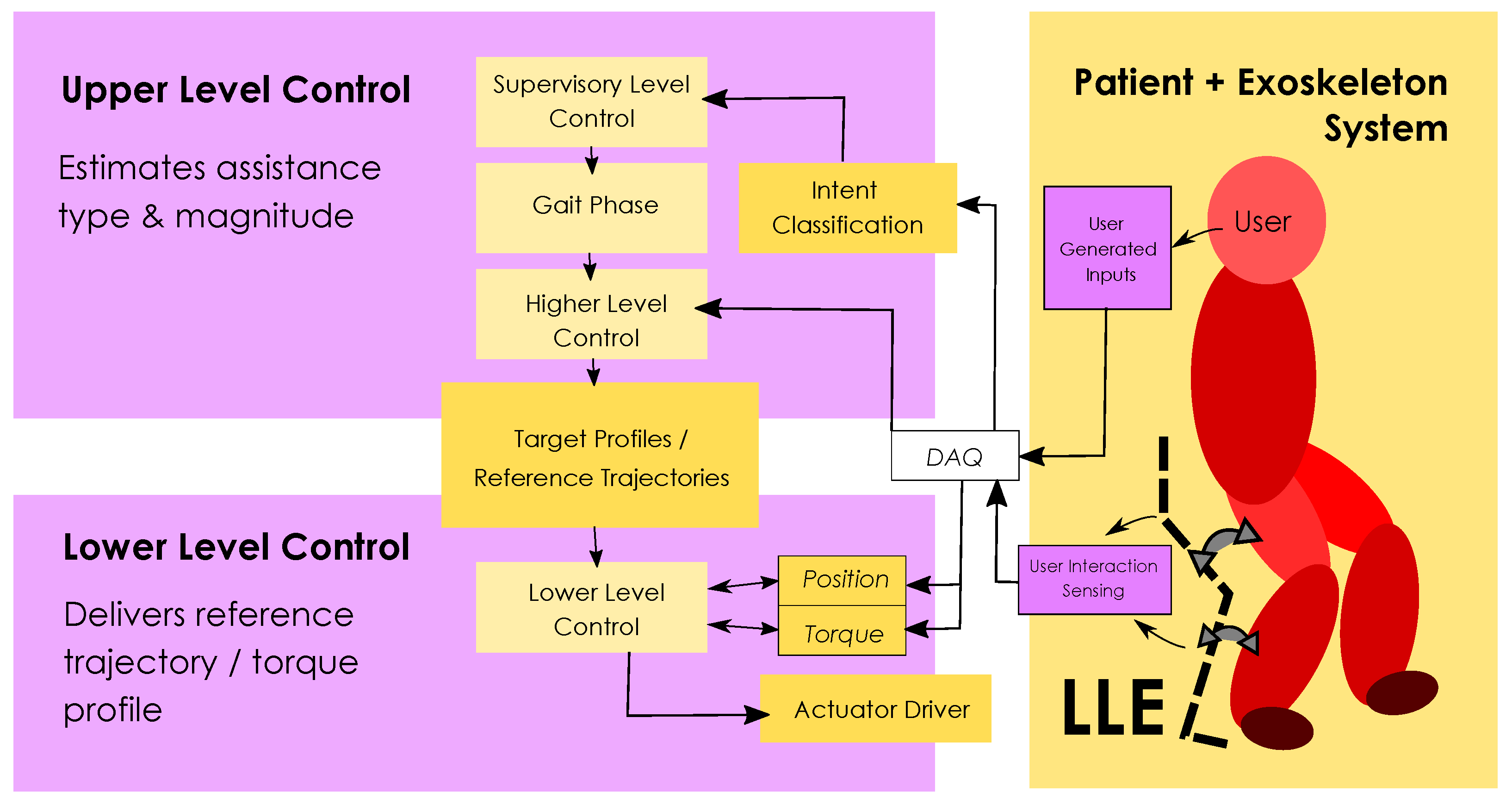

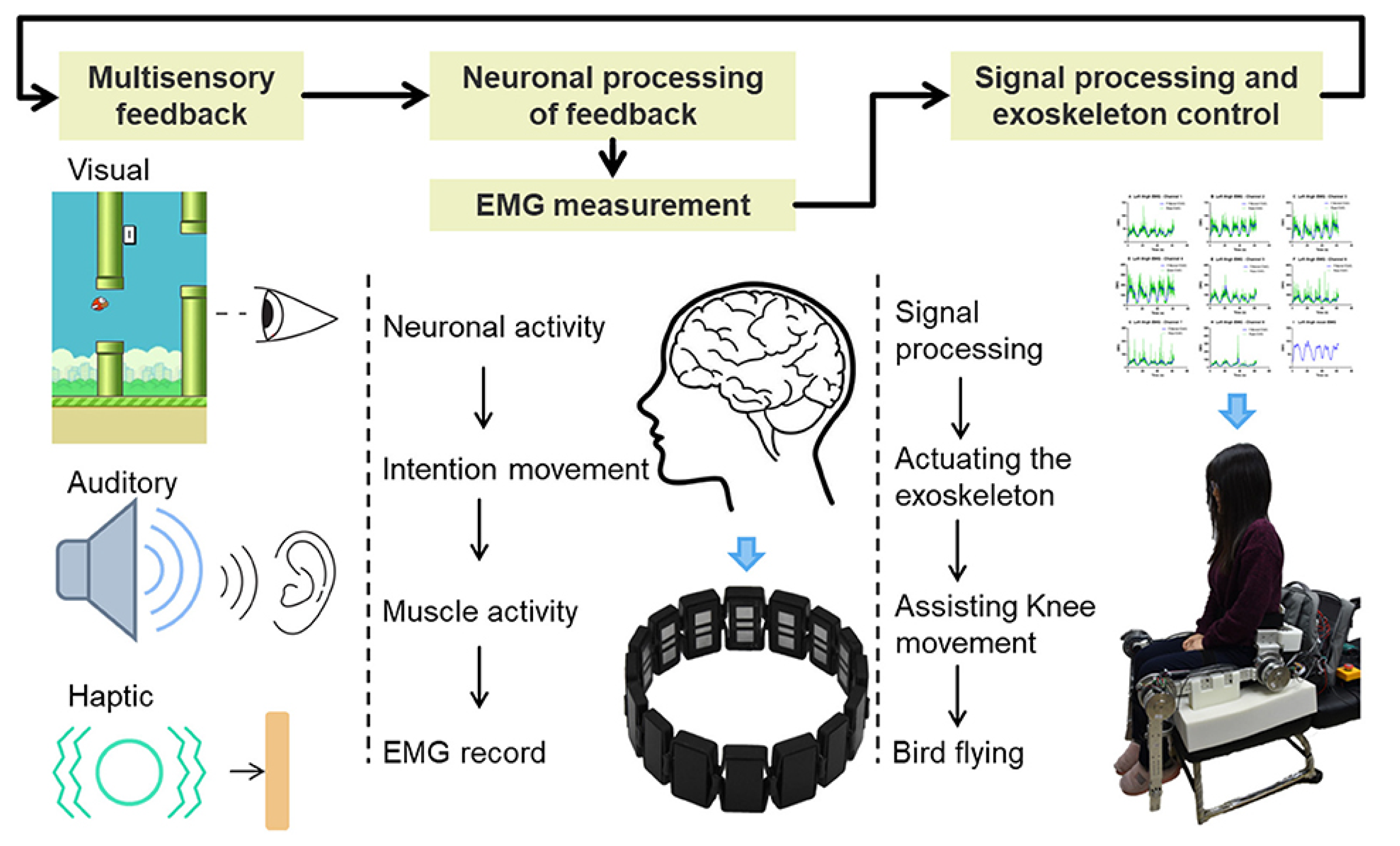

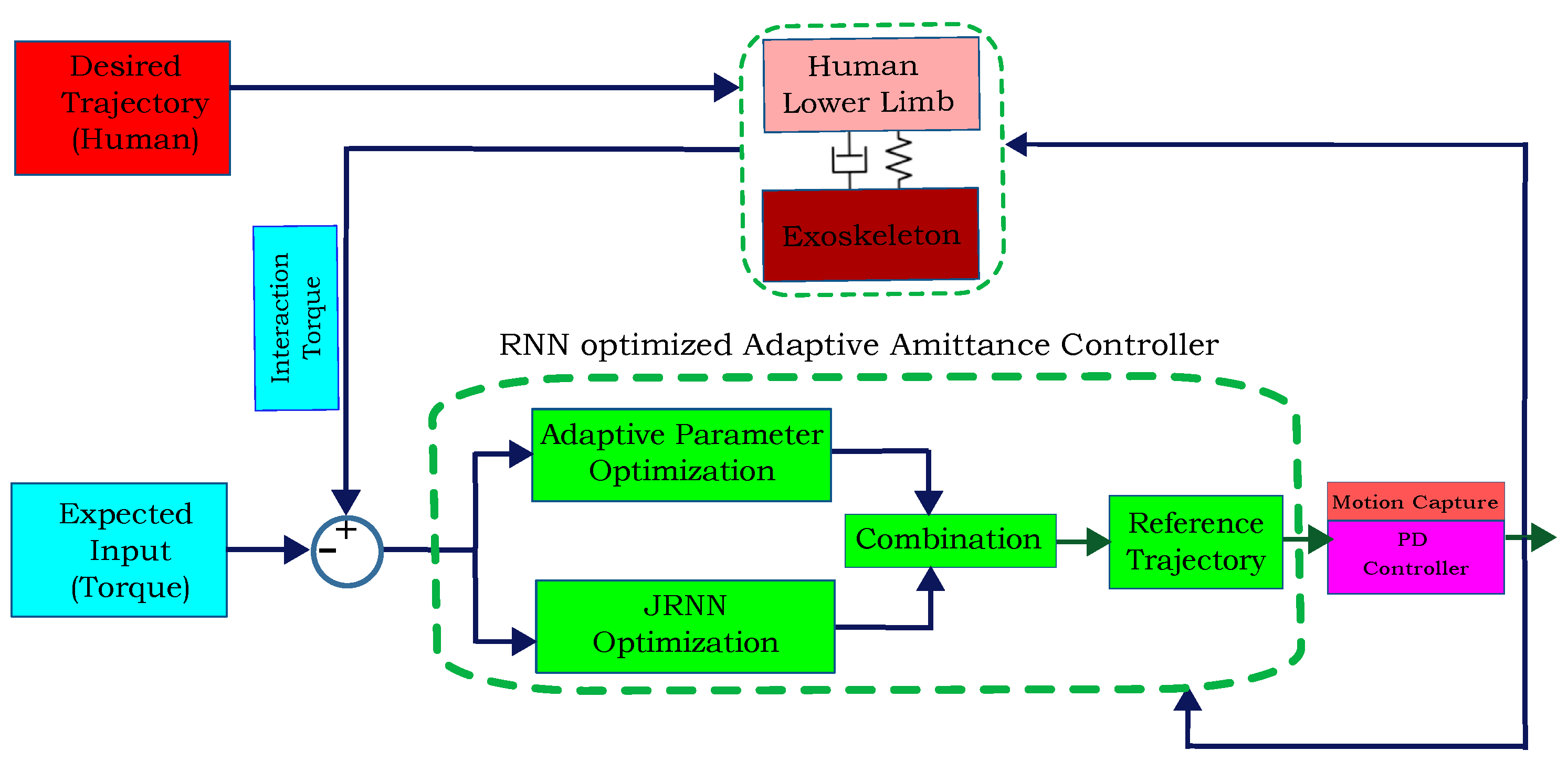
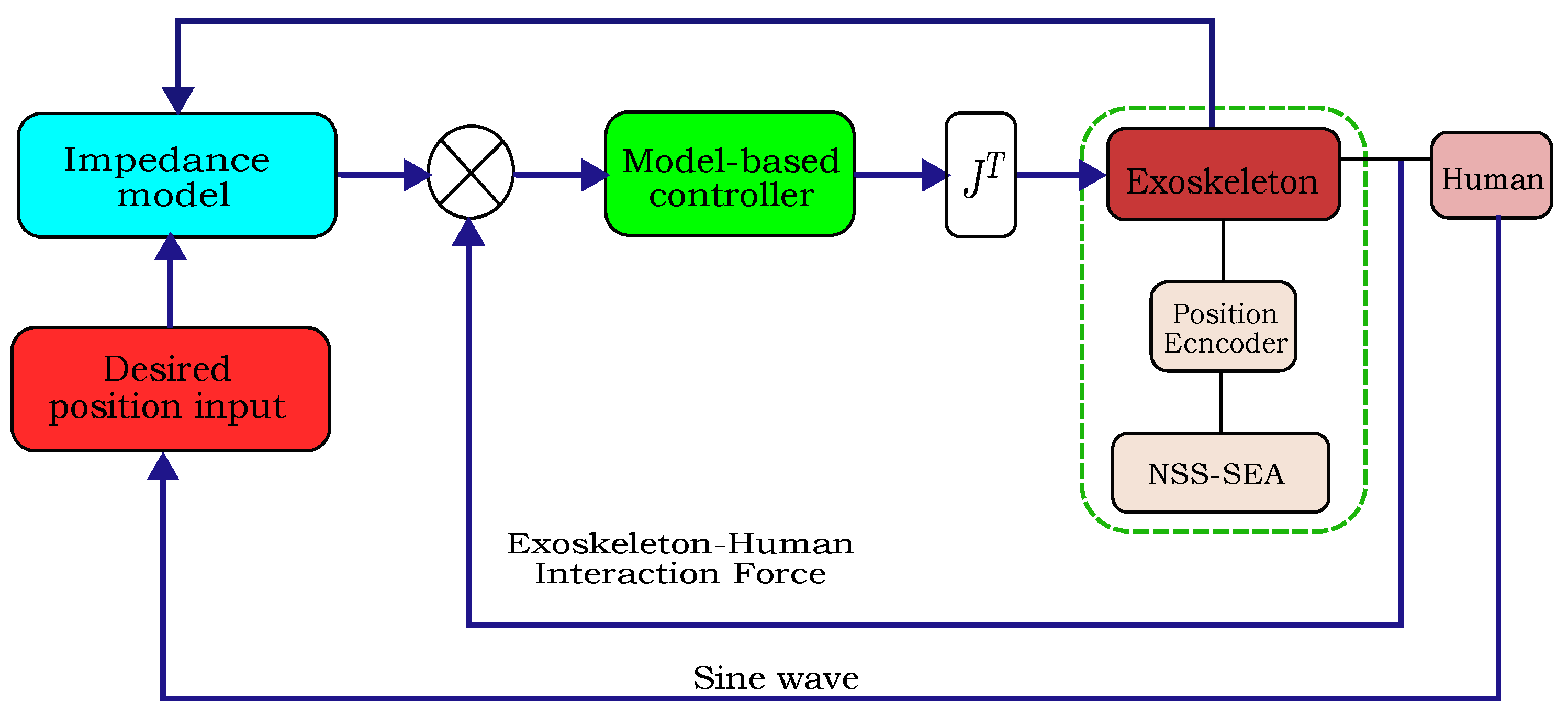
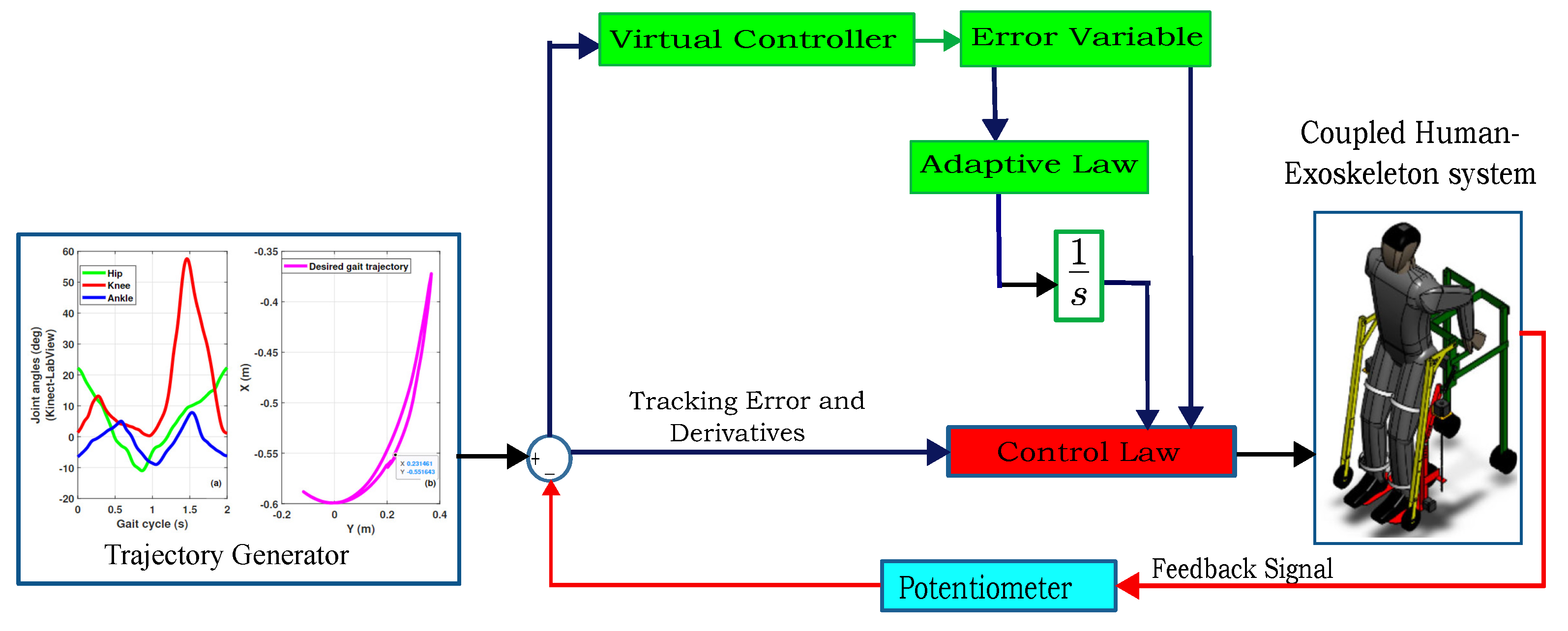

| Study (Year) | Targeted | Training | Upper Level (Decision Layer) | Lower Level (Servo Layer) | Development | |
|---|---|---|---|---|---|---|
| Joint | Mode | Supervisory Level | High Level | Stage | ||
| Ayas and Altas [25] (2017) | A | P, A | - | Adaptive Admittance | Fuzzy logic control | E |
| (Fuzzy logic based gain regulator) | ||||||
| Chen et al. [26] (2017) | HKA | P | FSR, IMU | - | PD | C |
| d’Elia et al. [27] (2017) | H | P | Optoelectronic | - | Adaptive oscillators | C |
| Patane et al. [28] (2017) | KA | P | IMU | - | PID | C |
| Yang et al. [29] (2017) | H | P, A | - | - | Command filter backstepping SMC | S |
| Lerner et al. [30] (2018) | A | P | FSM, FSR | - | PID | C |
| Khamar and Edrisi [31] (2018) | K | P | - | - | Backstepping SMC + nonlinear disturbance observer | S, E |
| Luo et al. [32] (2018) | HK | A | - | Adaptive impedance | - | S |
| (Fuzzy logic based gain regulator) | ||||||
| Han et al. [33] (2018) | HKA | P | - | - | Adaptive non-singular fast terminal SMC | S |
| Zhang et al. [34] (2018) | HKA | P | - | - | Intelligent PID based neural network + time-delay estimation | S |
| Taherifar et al. [35] (2018) | H | A | - | Adaptive admittance | Sliding position control | S, C |
| (RBF based gain regulator) | ||||||
| Aycardi et al. [14] (2019) | HKA | A | EEG, EMG, | - | - | C |
| IMU, LRF | ||||||
| Eguren et al. [36] (2019) | HKA | P, A | - | Variable stiffness impedance control | PD | E |
| Lyu et al. [37] (2019) | K | A | EMG | - | PD, PID | C |
| Chen et al. [38] (2019) | HKA | P | - | - | Fast terminal SMC | S, C |
| Chen et al. [39] (2020) | HK | A | - | Impedance | SMC | S, C |
| Almaghout et al. [40] (2020) | HK | P,A | - | Admittance | Supertwisting non-singular terminal SMC | S |
| Chen et al. [41] (2020) | HKA | A | - | Adaptive impedance | SMC | C |
| (Fuzzy logic-based gain regulator) | ||||||
| Gui et al. [42] (2020) | HK | A | EMG | - | SMC | S, E |
| Sun et al. [43] (2020) | HK | P | - | - | Adaptive fuzzy decoupling control | S, C |
| Yin et al. [44] (2020) | HK | A | EMG | - | - | C |
| Tu et al. [45] (2020) | HKA | A | - | Variable admittance | ASMC | C |
| Chen et al. [46] (2021) | K | P, A | FSM, FSR | Adaptive Impedance | PD (feedforward compensation) | C |
| Wang et al. [47] (2021) | H | A | SFS | - | Torque control | C |
| Andrade et al. [48] (2021) | HKA | A | - | Impedance control | PD control | C |
| Narayan et al. [49] (2022) | HKA | P | - | - | Singularity-free terminal SMC | S |
| Lian et al. [50] (2021) | K | A | - | Adaptive admittance | PD | S |
| (RNN-based gain regulator) | ||||||
| Mokhtari et al. [51] (2021) | HKA | A | - | Impedance | Adaptive high order super twisting SMC | S |
| Yin et al. [52] (2021) | HKA | - | FSM, FSR, IMU | - | - | C |
| Susanto et al. [53] (2021) | K | A | IMU | - | - | C |
| Hu et al. [54] (2021) | HK | P | - | - | Adaptive PD | E |
| Foroutannia et al. [55] (2022) | H | A | EMG, FSR | Impedance | PID | C |
| Laubscher et al. [56] (2022) | HKA | A | - | Impedance-SMC | - | C |
| Fuentes et al. [57] (2022) | HK | P | EMG, RNN | - | Adaptive non-singular fast terminal SMC | S, C |
| Hasan and Dhingra [58] (2022) | HKA | P | - | - | Super-twisting SMC | S |
| Moodi et al. [59] (2022) | HA | A | - | Variable impedance | Adaptive neural network | S |
| (Fuzzy logic based gain regulator) | ||||||
| Narayan et al. [60] (2023) | HKA | P | - | - | Adaptive backstepping | S |
| Narayan et al. [61] (2022) | HKA | A | - | Admittance | Computed torque | S |
| Su et al. [62] (2022) | H | P | - | - | Backstepping | S, E |
| Wang et al. [63] (2022) | HK | A | EMG | - | SMC | S, C |
| (GA-BPNN) | ||||||
| Zhu et al. [64] (2022) | HK | A | IMU | Impedance | PID | C |
| Roy et al. [65] (2022) | HKA | A | EEG | - | - | S |
| Qi et al. [66] (2022) | HK | A | FSM, FSR, IMU | - | - | C |
| Aljuboury et al. [67] (2022) | K | P | - | - | Model reference adaptive control | S |
| He et al. [68] (2022) | HK | P | - | - | RBF based adaptive sliding mode | S |
| Amiri et al. [69] (2022) | HK | P | - | - | Adaptive and swarm fuzzy control | S |
| Chen et al. [70] (2022) | HK | A | IMU | Variable Admittance | Extended state observer-based backstepping | C |
| Zhang et al. [71] (2023) | HKA | A | - | Variable Impedance | Fuzzy PID | S, C |
| (RBFNN-based gain regulator) | ||||||
| Chen et al. [72] (2023) | HK | A | EMG | Adaptive Admittance | PD | C |
| Quiles et al. [73] (2023) | HKA | A | EEG, IMU | - | - | C |
| Di Marco et al. [74] (2023) | HKA | A | EEG, EMG, IMU | - | - | C |
| Sun et al. [75] (2023) | K | A | - | Impedance | Model-based control | S, E |
| Foroutannia et al. [76] (2023) | HK | A | EMG, IMU, FSR | Adaptive-fuzzy impedance | - | C |
Disclaimer/Publisher’s Note: The statements, opinions and data contained in all publications are solely those of the individual author(s) and contributor(s) and not of MDPI and/or the editor(s). MDPI and/or the editor(s) disclaim responsibility for any injury to people or property resulting from any ideas, methods, instructions or products referred to in the content. |
© 2023 by the authors. Licensee MDPI, Basel, Switzerland. This article is an open access article distributed under the terms and conditions of the Creative Commons Attribution (CC BY) license (https://creativecommons.org/licenses/by/4.0/).
Share and Cite
Narayan, J.; Auepanwiriyakul, C.; Jhunjhunwala, S.; Abbas, M.; Dwivedy, S.K. Hierarchical Classification of Subject-Cooperative Control Strategies for Lower Limb Exoskeletons in Gait Rehabilitation: A Systematic Review. Machines 2023, 11, 764. https://doi.org/10.3390/machines11070764
Narayan J, Auepanwiriyakul C, Jhunjhunwala S, Abbas M, Dwivedy SK. Hierarchical Classification of Subject-Cooperative Control Strategies for Lower Limb Exoskeletons in Gait Rehabilitation: A Systematic Review. Machines. 2023; 11(7):764. https://doi.org/10.3390/machines11070764
Chicago/Turabian StyleNarayan, Jyotindra, Chaiyawan Auepanwiriyakul, Sanchit Jhunjhunwala, Mohamed Abbas, and Santosha K. Dwivedy. 2023. "Hierarchical Classification of Subject-Cooperative Control Strategies for Lower Limb Exoskeletons in Gait Rehabilitation: A Systematic Review" Machines 11, no. 7: 764. https://doi.org/10.3390/machines11070764
APA StyleNarayan, J., Auepanwiriyakul, C., Jhunjhunwala, S., Abbas, M., & Dwivedy, S. K. (2023). Hierarchical Classification of Subject-Cooperative Control Strategies for Lower Limb Exoskeletons in Gait Rehabilitation: A Systematic Review. Machines, 11(7), 764. https://doi.org/10.3390/machines11070764







